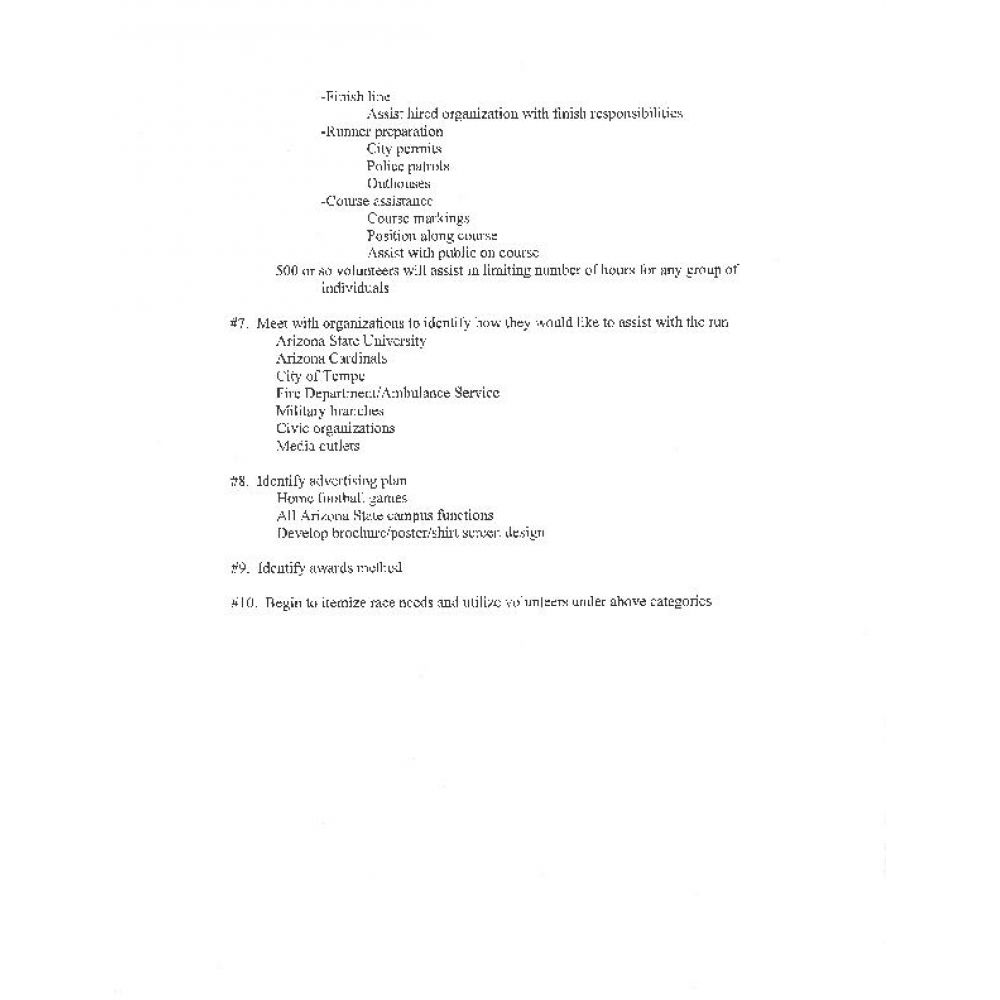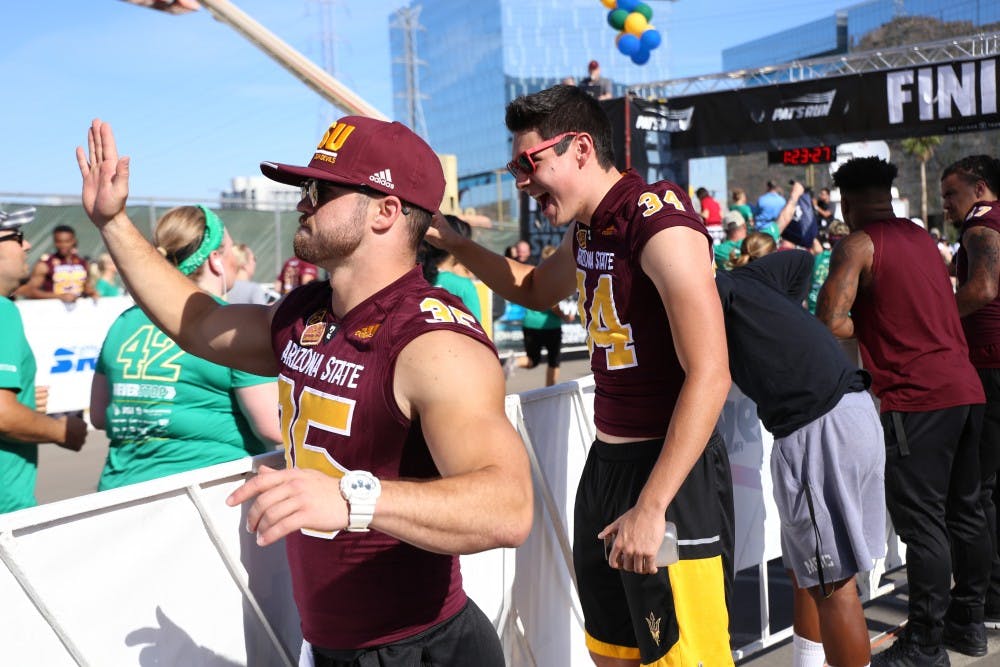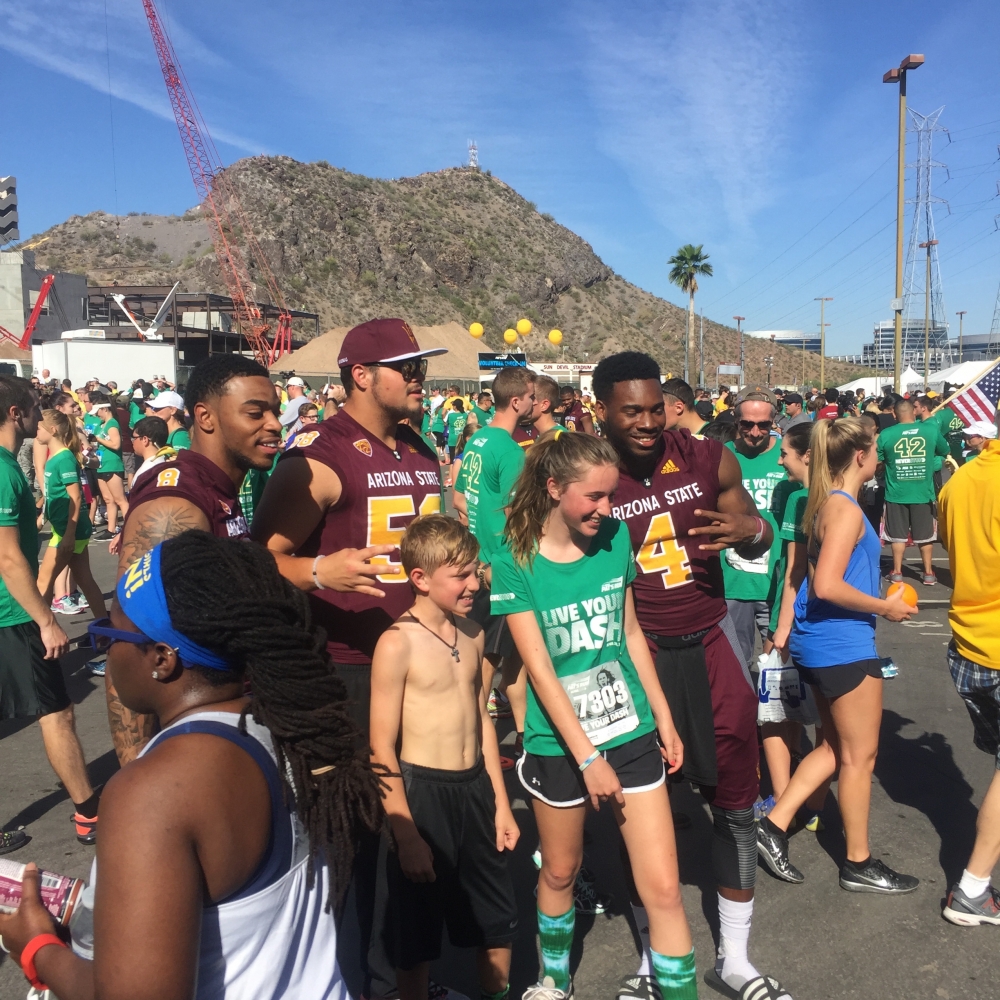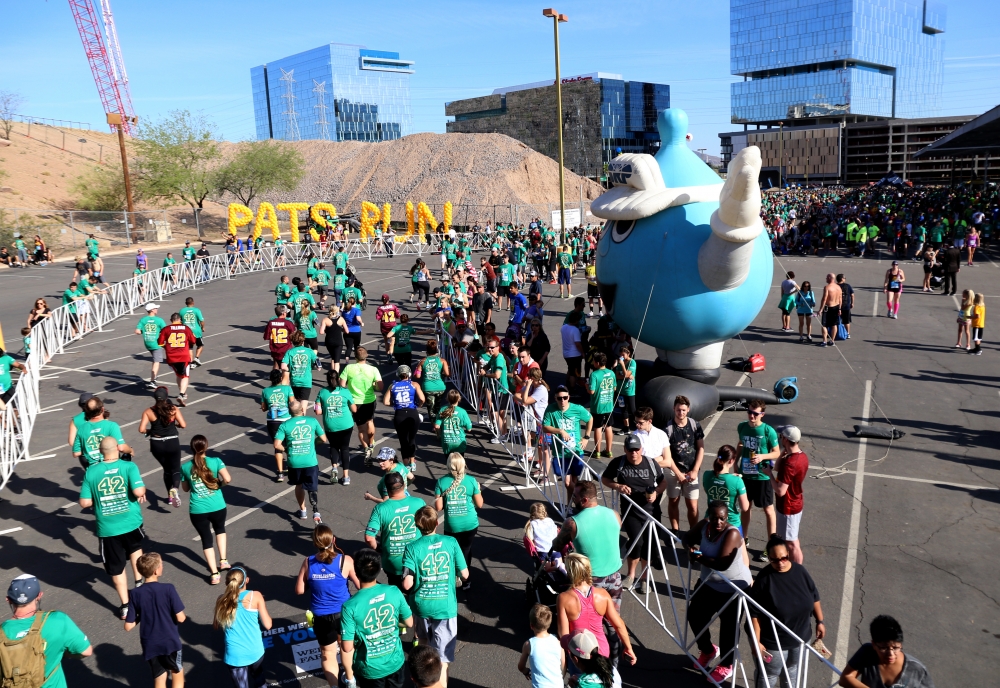I was 7 years old in the summer of 2002, the first time I saw Pat Tillman’s face and read his name in the pages of Sports Illustrated for Kids.
Just eight months earlier, I was sitting on the carpet of my first grade classroom, overcome with grief and fear as my teacher tried to nervously assure my classmates and I on the morning of the terrorist attacks on Sept. 11, 2001 that we were safe.
Patrick Daniel Tillman and his brother Kevin both turned down careers as professional athletes to heed the call to protect the freedom of Americans and our allies across the world and to liberate the oppressed in the Earth’s most desolate and darkest corners.
When my alarm went off before dawn Saturday morning and I headed to Sun Devil Stadium, it was fitting that I had a brief moment of deep introspection — I thought of my grandfather George and his brothers Carl, John and Tom who all served in World War II, and my uncle Mickey was a Marine in Vietnam, the last surviving military veteran in my family.
I was one of more than 20,000 people who participated in Pat’s Run, a 4.2-mile race that normally finishes on the 42-yard line inside Sun Devil Stadium, but an alternate finish line northeast of Lot 59 was arranged due to ongoing construction.
As an avid runner with several half-marathons under my belt, this wasn’t supposed to be an intimidating distance for me. But I’ve never felt more accomplished than I did running in the company of thousands of Sun Devils and military families all united to remember the life and legacy of the man who was by any definition the quintessential Arizona State Sun Devil and American hero.
The State Press interviewed several Pat Tillman Scholars and sources close to the Tillman Foundation to chronicle the origin of Pat’s Run, as well as others who were influenced by his legacy.
These are their stories.
The Architect: Perry Edinger
Check out #PatsRun founder Perry Edinger testing out this year's race shirt. He'll be wearing bib No. 1 Saturday! pic.twitter.com/4D46rS0ou8
— Pat Tillman Fnd (@pattillmanfnd) April 21, 2016
Former ASU athletic trainer Perry Edinger founded Pat’s Run, which was created shortly after Tillman was killed in the line of duty by friendly fire in April 2004.
“(Executive Director Alex Garwood) was in charge of the Tillman Foundation at the time, and we wanted to do something to get together and remember (Tillman)," Edinger said. "Pat wouldn’t have liked a golf outing; we wouldn’t have done a tennis outing.”
But Tillman had run in a marathon — so it seemed natural to create an event that would share his passion for athletic excellence, distilling it into a format that runners and walkers ranging anywhere from 7- to 80-years-old could appreciate.
“The first year, I wanted 5,000 (entrants),” Edinger said. “I was told we’d have 800. I was laughed at – I went out and bought 5,000 shirts."
Today, thousands of participants fly out from across the country, including alumni who bring their children to give them the opportunity to connect Tillman to their alma mater.
“Lots of people come because they want to learn about Pat,” Edinger said. “People come searching for new memories. They’re talking with other people and honoring what he stood for, and get a chance to hear things about him that they haven’t heard before.”
Photo by Stefan Modrich
“Getting the kids involved, and to understand who Pat was, that was a big deal,” Edinger said. There’s a lot of former ASU football players that come back, and there’s a chance to mingle with them, and the current team.”
As Edinger said, the enticing challenge of Pat’s Run lies in what is unknown to the first-time participant, many of whom might frequent 5Ks but are unaccustomed to such an unorthodox distance.
“If you’re running 4.2 miles, you’re going to set a personal record no matter how fast you go if you’ve never ran that far before,” he said.
The Entrepreneur: Erik Wittreich
Erik Wittreich was the first Tillman Scholar to cross the finish line today. #PatsRun #LiveYourDash #NeverStop pic.twitter.com/httg0CgsGA
— Pat Tillman Fnd (@pattillmanfnd) April 23, 2016
“I saw myself doing a desk job. It was the ‘right path, the natural path.’”
Erik Wittreich’s path to earning his degree from Stanford’s graduate business school and forming a talent analytics startup called Hinted was anything but ordinary.
He came to a fork in the road when he sat down with an Army recruiter on Sept. 12, 2001, studying economics and business as an undergraduate.
“Looking at my career options — this would be the time in my career to try something different,” Wittreich said. “I wanted to serve my country. Worst case, if this doesn’t work out, I’ll have a compelling story to tell.”
Wittreich served seven years of active duty as a U.S. Army Green Beret, and one year in the National Guard.
“It’s definitely a part of me I hold dearly, I hold deep relationships with the people I served with. I think he saw this path of selfless service.”
At a 2002 reception battalion, Wittreich was standing near a soldier named Mike Long when he first saw Tillman.
“We’re not supposed to talk or hear a murmur,” Wittreich said of the encounter. “Mike turns to me and says, ‘Erik, Pat Tillman’s here.’”
Tillman’s ambition left a lasting impression on many soldiers who served alongside him, including Wittreich.
“This year’s race motto is ‘Live your dash,’ and he did that,” Wittreich said. “He had a lot of energy, he enjoyed his friends, his family, and every task he carried out with the utmost sincerity.”
As a 2013 Tillman Scholar, he was inspired to contribute to the Tillman Foundation when he decided to team up with another soldier, John Andrews. The two set an initial goal of $5,000.
“Within a couple days, we hit the goal of $5,000,” Wittreich said. “We quickly bumped it to $10,000 then $15,000 and $20,000. Over 42 days, we raised just over $22,000. I think that shows an appreciation of our friends and family for enabling veterans to have a plan to go back to school.”
“I wanted to make my mark in the business world and do something different,” Wittreich said. “There was an interest in tech because it’s constantly changing.”
This vision helped plant the seed of inspiration for Hinted, an action-based free app to help facilitate human resources movement. Think of Hinted Labs as highly-skilled corporate peer mediators — putting users first to give and receive honest, candid feedback without the fear of potential repercussions.
“I come across two of my grad school classmates, and they wanted to take a class, Stanford allows you to incubate a business for credit,” Wittreich said. “My colleague felt he wasn’t getting sufficient feedback from professors.”
Ultimately, the experience Wittreich gained as a squad leader where he supervised as many as 2,000 soldiers and the enthusiasm with which he has approached giving back to the Tillman Foundation has helped his business flourish.
“The military gave me that initial toolbox and skillset, and the confidence to know when to take charge and when to yield to others,” Wittreich said. “I’ve been lucky.”

Photo by Johanna Huckeba
The Alumnus: Tyler Green
Tyler Green is an ASU alumnus and has been a Sun Devil Athletics season ticket holder since 2003.
“We've never missed a race and hopefully never will,” said Green, a Boston native whose brother also attended ASU.
His 7-year-old son is a “militant gung-ho ASU fan,” Green said. “If he sees somebody at a restaurant with a U of A shirt, he’ll tap me under the table and give me a thumbs down.”
Tillman left such a profound impact on Green that his 10-year-old daughter’s middle name is Tillman.
#PatsRun #LiveYourDash pic.twitter.com/8IdKbtsU9Q
— Stefan Modrich (@StefanJModrich) April 23, 2016
“I had the pleasure of getting to meet him and know him from a couple of classes, we were in the business school together,” Green said. “I thought the world of him. Everything that he stood for, he was unbelievably motivated, smart, principled, of high integrity — if you could be one person, he’s someone you could aspire to be like.”
Green’s account is similar to many who were on campus at the same time Tillman was. His impact seems to gather more momentum each April as fond memories are shared and re-shared to growing audiences.
“It’s always been important,” Green said. “He’s someone who I would consider my hero, and someone who is willing to sacrifice for everybody. He’s the kind of person that we can aspire to be like."
Tillman remains the most significant ASU alumnus in school history, and who better for future Sun Devils (and heaven forbid, even Wildcats) to emulate?
“It’s unbelievable. It’s really cool to see that legacy grow,” Green said. “We try to go with the kids every year, and we use it as an inspiration as a chance to reflect upon what Pat meant to them.”
The Educator: Joseph Wheaton
Joseph Wheaton was one of nearly 80,000 Americans to enlist in the military after 9/11.
“There was some motivation born out of that tragedy,” Wheaton said. “I had always had an interest in special operations.”
He served six deployments to the Middle East in five years as a squad leader.
In his return to civilian life, he spent two years traveling with Teach for America, a non-profit dedicated to giving quality education to students in impoverished urban and rural areas.
“It’s a humbling experience,” Wheaton said. “You read the profiles of past and present scholars, and many of them have been exemplary, and served in combat. They’re motivated to continue to serve, and that ties us together. To be amongst them, it’s humbling and motivating.”
Wheaton was working to become a prosecutor, and while attending ASU’s Sandra Day O’Connor College of Law he worked for the Maricopa County Attorney’s office.
While law enforcement is a noble and under appreciated profession, Wheaton realized his ability to make an impact on future generations would have to come at an earlier stage in their development.
“If I really wanted to reach people to make a difference, I had to get to them before they made a bad decision,” Wheaton said.
His experience as a squad leader shaped his ability to lead in a classroom setting.
“You have to be put in a position to make hard decisions under stressful conditions,” Wheaton said of his time in the military. “I don’t think you could be put in a more difficult situation than that. I have a clear view of my role as a leader, and that differentiates me from other teachers.”
The Tillman legacy has since spread nationally, but the local grassroots effort to commemorate one of Arizona’s most celebrated heroes has resonated with Sun Devils like Wheaton.
“It’s kept his name alive,” Wheaton said. “(Pat’s Run) has grown into a huge event where his legacy of excellence and his service are brought to the forefront, and people are participating in it.
"To lead from the grave, to inspire from the grave, not many people can do that. To have a positive impact, and to put others before yourself, that’s the legacy that Pat left.”
The Logistical Mastermind: Doug Tammaro
Glad to catch up with 11 year old Tillman Cummings from California. Well done on name mom and dad! pic.twitter.com/lXc1OuP88K
— Doug Tammaro (@DougTammaro) April 23, 2016
Most ASU season ticket holders and local media members know Media Relations Director Doug Tammaro as the logistical mastermind behind the scenes of the football, men’s basketball and golf programs.
He arrived at the course at 4 a.m. on race day and helped public address announcer Jeff Munn identify racers as they streamed across the finish line in bunches by tweeting some notable results and giving shoutouts to runners, ranging from 9-year-old Kyah Zurek to 75-year-old David Millbranth, as they completed Pat’s Run.
Then, Tempe shut down and dropped everything as 20,000+ crowded into Lot 59 on race day, with radio and TV stations lined up along the course and at the finish.
But it wasn’t always like this.
It all began in May 2004 with Tammaro, Edinger, and Tillman Foundation Executive Director Alex Garwood, Mark Zimmer, head equipment manager for ASU athletics, Frank Ugenti (a relative of Tillman) poring over a two-page outline at BJ’s Brewhouse and Restaurant in Chandler.
“You’d crack up at how basic it was,” Tammaro said of the original document the founders used to plan out the race. “It’s come a long way.”


What started as a modest effort to honor a selfless hero who didn’t want to bask in the spotlight as a serviceman or a player, grew to become the flagship event of one of the premier charity organizations in the U.S. (The Tillman Foundation is one of a select few nonprofits to be affiliated with the NFL.)
“Perry (Edinger)'s the one who said ‘we can do this,’” Tammaro said. “He had a vision of 2,500 people. The last few years, we’ve had to cap it because there was only so much room on the street.
“(The first race) had 2,000 people. … Now it’s turned into the second-biggest event on ASU’s campus outside of a football game.”
Never too young to learn about #PT42 pic.twitter.com/DMV9aRYyzi
— Doug Tammaro (@DougTammaro) April 23, 2016
What would Tillman say about all of this?
“I think the first thing he would say is ‘thank you,’ to anyone who is running and making themselves better,” Tammaro said. “We have a lot people who circle this event as their starting point, who say ‘I’m training for Pat’s Run.’
"If he were to see some people that aren’t perfect running, racing for a great cause, that would make him really happy.”
Twelve years since his untimely death, the Tillman Foundation is at its strongest point – there are 32 shadow runs across the country populated by alumni and many others who have come to support the foundation over the years.
“There’s not many people who could pull that off,” Tammaro said. “The passing of Pat has brought together lots of different people who have met and inspired each other – there are lot of great things that have come out of a really terrible (tragedy).”
Reach the reporter at smodrich@asu.edu or follow @StefanJModrich on Twitter.
Like State Press Sports on Facebook and follow @statepressport on Twitter.






